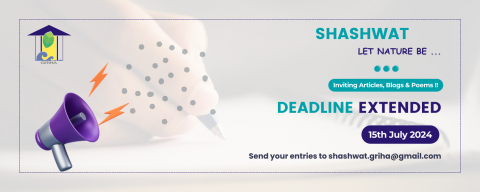Shashwat 2024

GRIHA Council invites you to contribute articles, blogs, poems and other creatives to the 11th edition of the annual magazine ‘Shashwat’. The theme of this year’s summit is ‘Accelerating Climate Action in the Built Environment’. We encourage you to explore and write about the sustainability strategies involved in creating and implementing effective action plans. This can include the importance of action plans in achieving specific goals, sharing examples of successful stories, providing insights on best practices and much more.
The entries must be submitted through email to shashwat.griha@gmail.com with the subject line: Article/Blog/Poem/Creatives for Shashwat 2024, latest by 15th of July 2024.
Guidelines for submitting the entries
A. Guidelines for entries
1. The word count of the articles should not exceed 800 - 1000 words.
2. The word count of the blogs/poems/creatives should not exceed 500 words.
3. The title of entries should be short and crisp.
4. The font should be Times New Roman (size 12), and margins should be normal (i.e. 1" all sides).
5. The entries should be submitted in a word format.
6. Plagiarism in any form is not acceptable.
7. The use of references and/or endnotes is strongly encouraged, as they increase the relevance and significance of an article. Include all appropriate source information (e.g., author, publisher, the title of book or article, magazine name, date/year of publication, country of publication, etc.) in parenthetical style referencing (examples mentioned below). The author is responsible for obtaining any necessary permission for quoted or borrowed material.
8. Referencing style: Chicago referencing style 17th edition
Refer https://libguides.library.usyd.edu.au/c.php?g=508212&p=5426978 (Source: The University of Sydney) for sample.
Examples for referencing
- Ministry of Statistics and Programme Implementation (MoSPI). 2020. Energy Statistics 2020. New Delhi: MoSPI
- Bureau of Energy Efficiency (BEE). 2019. Details available at http:// https://beeindia.gov.in
- Awasthi, A. K., M. Wang, Z. Wang, M. K. Awasthi, and J. Li. 2018. E-waste management in India: a mini-review. Waste Management & Research 36(5): 408–414
- Balasubramanian, A. 2015. The Wastelands In India. Mysore: Centre for Advanced Studies in Earth Science, University of Mysore
B. Guidelines for images and graphics
- Number of high-resolution images per entry
- Articles: Minimum of 4 and a maximum of 6 images
- Blog & Poem: Maximum 3 images
- Other creatives: As required, depends on type of the creative
- Author’s photograph: Only 1
- High-resolution graphics (tables, charts, graphs etc.) as per the content. (In editable format)
- File Format: JPG format (All images and graphics)
- File size: Maximum 1 MB (All images and graphics)
- Quality: Minimum 300 DPI, must not be blurred or pixelated
- Source: Self-clicked or images from the Shutterstock website only to avoid copyright issues.
- Submission details
- All images and graphics must be submitted in a separate folder in addition to being placed for reference in the word document. Images should not be embedded in the word document.
- Relevant captions should be shared for all images and graphics.
C. Guideline for author bio-note:
1. The word count should be 20-30 words in which the current designation details along with area(s) of interest should be mentioned. In case an author has been felicitated/ honoured, then that should be mentioned.
2. It should also contain contact details (email id and contact number) of the author(s) so that the readers may connect with them.
3. Note: The information shared by the authors can be published as a part of content in the magazine.
4. Example: Dr ABC, a PhD from the PQR School of Architecture and Design has twenty years of experience in developing cost-effective, sustainable ways of designing community housing projects. In his current role as the CEO of XYZ, he has successfully brought ‘green designing’ to the forefront of agricultural practices.
5. The bio note should be shared as a separate word file.
The editorial committee formed by GRIHA Council will choose the entries from those submitted for publication. The criteria for the selection are relevance to the originality of scope, theoretical sophistication, and pictorial representation, amongst others.
NOTE: The selection process ensures fairness and transparency by treating all applications on a chronological basis, i.e., applications will be processed in the order they are received, ensuring that those who sent earliest have the best chance of being selected.